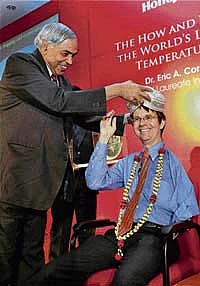

In his maiden lecture in Bangalore under the Honeywell-Nobel Laureate Lecture series on Tuesday, Dr Cornell said that with the help of cold gases created by Bose-Einstein condensation (an achievement that won him the Nobel prize), they would attempt at creating a model of black hole. “I am interested in seeing the Hawking radiation (named after Stephen Hawking) emitted by the black hole. There is a theory that black holes are not really black but that they have a glow. But as we cannot see it, we are hoping that we can detect the sound waves emitted by the light by modifying the existing Bose-Einstein condensation,” said Dr Cornell, who teaches in University of Colorado.
Although, scientists had not been able to come up with commercially viable applications, Bose-Einstein condensation had some niche application. However, more technology driven applications would happen in the future, he felt. For instance, it would help in giving a microscopic view in the world of quantum mechanics. This in turn would enable scientists to comprehend nanotechnology and micro electronics.
Dr Cornell believes that innovation is often the work of young people. “Most physics researches are done by students and not the professors,” he pointed out. He said that at least three institutes –– IISc, Raman Institute and Indian Institute of Astrophysics –– were conducting either theoretical work or experiments on this field.
